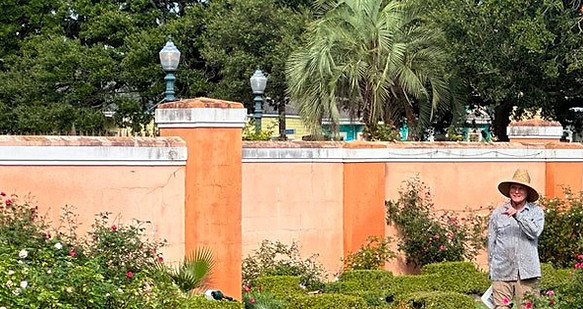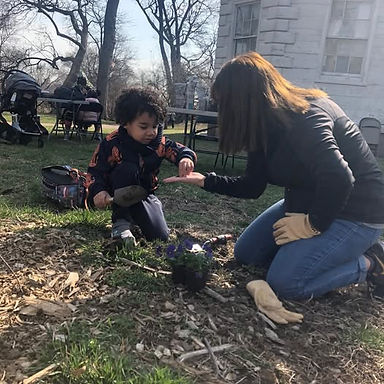
Projects
The “Save the Rambler” Initiative
To kick off this initiative, funding to create a nursery for this collection of more than 300 ramblers was provided by the Heritage Rose Foundation. Claude Graves has been the force behind the preservation and reintroduction of ramblers into the marketplace.

AMERICAN ROSE SOCIETY
The American Rose Society (ARS) has a collection of more than 300 rambler varieties at America’s Rose Garden, the largest collection of rambler roses in the U.S. and one of the largest collections in the world. It has undertaken a program to preserve and grow rambler roses throughout the United States.
The ARS recognizes the significance of these historic roses, the original climbing roses that were grown in great gardens of the world. Many varieties in the ARS collection are one of kind in the U.S. and not available to gardeners or botanical gardens today. ARS President, Diane Sommers, stated, “the ARS goal is to change that through partnerships with retail nurseries who will propagate and sell ramblers, and public gardens that will display rambler roses for public enjoyment and education.
This program aligns with the American Rose Society mission to promote the culture, preservation and appreciation of the Rose, and to improve its standard of excellence for all people through education and research.”



The Heritage Rose Foundation awarded a $5000 grant to the Remember Me Rose Garden located in Shanksville, Pennsylvania. This new rose garden was created as a living tribute to the crew and passengers who sacrificed their lives to overwhelm the hijackers of United flight 93 on 9/11. Located just ¼ mile east of the actual crash site, the rose garden is a compass design situated on a 13 acre site donated by the families of
these heroes. The Remember Me Rose Garden continues to grow, becoming a destination garden with a significant collection of heritage roses.
The list of the heritage roses donated by Malcolm Manners and his horticulture students of Florida Southern College focuses on varieties hardy in horticultural zones 7, 6, and 5. The following varieties were planted in 2023:‘Baronne Prevost’, “Old Town Novato,” “Grandmother’s Hat,” ‘Autumn Damask’, ‘Stanwell Perpetual’, “Ethel Yount’s White,” ‘Marchesa Boccella’, ‘Arnold’, “Barbara’s Pasture Rose,” ‘Rose de Rescht’, ‘Reine des Violettes’, ‘Paul Neyron’, and “Maggie.”In addition to the display of roses, free workshops are offered in the garden twice a year with a focus on basic rose maintenance


You can never visit Armstrong Park and see all the roses at peak bloom on the same day, but there are definite flushes, especially in the spring and fall/early winter.
There are over 125 different roses, making this one of the largest public collections in the world of old roses that do well in warm climates.
The garden has been a project of the New Orleans Old Garden Rose Society since 1992 in cooperation with the City of New Orleans. No public funds are used.
The Heritage Rose Foundation has contributed funds to aid in its care.


Heritage Rose District of New York City
The Story of the Heritage Rose District of New York City Project
In the spring of 2009, the New York Times ran a story about heritage roses with a focus on Mr. Harison of 'Harison's Yellow'. Betty Vickers and Doug Brenner joined Stephen Scanniello in the planting of heritage roses that once grew in Harlem - the site of Trinity Church Cemetery in New York City. The roses were donated by Gregg Lowery and Mike Shoup. They planted: 'Souvenir de la Malmaison', 'Mme. Boll', 'Harison's Yellow', Rosa gallica, 'Fellenberg', 'Rose du Roi, 'John James Audubon' (one of Mike Shoup's creations - the cemetery was created on Carman's estate, close to Audubon's estate), and a rose found in Baltimore with study name of "Greenmount Red".

FALL 2009
The article mentioned the Heritage Rose Foundation. A week after the article ran, Stephen received a phone call from Manhattan Borough President Scott Stringer. His office was interested in talking about the rose plantings. Their dream: to create a Heritage Rose District in the neighborhood of the cemetery, an area that includes the newly founded historic district of Audubon Park. The city of New York invited the Heritage Rose Foundation to help create the first ever Heritage Rose District.
Community groups, historical societies, and cultural institutions enthusiastically embraced this project. These institutions included: Morris-Jumel Mansion, Church of the Intercession, Trinity Church Cemetery, Hamilton Grange, Hispanic Society, Harlem and the Heights Historical Society, City College of NY, Hudson River Restoration Project (funded entirely by Bette Midler), and numerous community groups as shown in the List of Organizations and their links at the end of this article.
All of the groups that accepted roses agreed to care for them. Each group had an army of eager volunteers.
The Heritage Rose District generally encompasses the western portion of Northern Manhattan between West 130thand West 162nd streets, with Broadway and Trinity Cemetery (final resting place of George F. Harison and Daniel Boll) at its nexus. The neighborhoods of West Harlem and Washington Heights – both with ample open spaces and a rich history – provide a perfect setting for growing and displaying roses, especially when plantings are inspired by local heritage.
On Oct 24, 2009, volunteers planted over a hundred heritage rose bushes at the following nine sites within the Heritage Rose District: Trinity Church Cemetery and Mausoleum, Church of the Intercession, the plaza at 155th Street and Riverside Drive, Audubon Terrace (the former site of John J. Audubon’s estate), Broadway Malls at 153rd Street and Broadway, Morris-Jumel Mansion (the oldest house in New York City), Montefiore Park at 137th Street and Broadway, Jackie Robinson Park at 145th Street and Edgecombe Avenue, and City College Campus on Amsterdam Avenue between 136th and 137th Streets.
The NYC Department of Parks & Recreation generously committed to constructing and maintaining a new, permanent planter at the corner of 155th Street and Riverside Drive, as well as to provide soil, compost and water for all of the rose bushes that fall within the Parks Department’s jurisdiction. In each instance, the roses planted were varieties that once grew in Manhattan during the 18th and 19th centuries. In fact, many of the roses were originally grown in gardens located in Northern Manhattan.
Five nurseries were willing to donate whatever we need for this project : Brookville Nursery, Vintage Gardens, The Antique Rose Emporium, Roses Unlimited and Der Rosenmeister.
Roses came also from Cris Maurer and Stephen. Irises were donated by Presby Memorial Iris Gardens, Cris Maurer and Betty Vickers.
Over the years, additional roses were donated by the former Sacramento Historic Rose Garden, with musk roses and Bermuda Mystery roses donated by Malcolm Manners and the Florida Southern College. Florida Southern College students have repeatedly participated in rose pruning and propagation events with neighborhood children.
Much has changed over the past 15 years, but many of the roses remain. Stephen is in discussion with Trinity Church Cemetery and Mausoleum about increasing their heritage rose collection.
"We also had participation of a positive nature. Some of the neighborhood kids jumped into the big planting bed at City College New York, first assisting Lee Ginenthal (who donated big, beautiful cold-climate roses and drove them to the site for us!), then heading over to give Stephen and Dana hand. Mommas watched proudly (if a bit warily – what ARE these people doing??) And up at Morris-Jumel Mansion, Camilla Huey had the assistance of a group of Bronx teenagers, all about to graduate from high school, full of plans to go off to college next year! I was delighted beyond words when one of them turned over a spade full of earth, found a tulip bulb, and – in great surprise - said, “Yo!” These kids created a bed for the roses, first removing roots that were almost as big as they were."
Betty Vickers
Friends of Vintage Roses
Support the Preservation the Lowery-Robinson Collection of Old Roses
Mission Statement of Friends of Vintage Roses
The Friends of Vintage Roses exists to preserve and enhance the unique and extensive collection of historic roses developed by Gregg Lowery and Phillip Robinson, to establish the collection in a garden, and to share the collection with other public rose preservation efforts, for the purpose of educating the public about the importance of the rose to human history, cultures, technology and science.
Nearly thirty years ago, Gregg Lowery and Phillip Robinson began to amass an unparalleled collection of old garden roses on a 2.5 acre lot in Sebastopol, California. Now the collection is threatened with disappearing, and time is of the essence to save these old roses. In order to preserve the collection for future generations, a nonprofit organization is known as the Friends of Vintage Roses (FoVR).
Rosarians world-wide consider the Robinson-Lowery collection of historic roses to be one of the most complete collections of old roses assembled anywhere. The collection brought international attention to the Pernetiana group of Hybrid Teas, a seminal historic rose group of great importance to rose history. It contains the most complete collections of Hybrid Perpetuals, Bourbons, Gallicas, Hybrid Chinas, Teas, Noisettes and Chinas in North America.
Become a member or donate to further TFoVR’s Mission. TFoVR is a nonprofit 501(c)(3) tax exempt organization, Tax ID is 45-5624170, and as no goods or services will be provided in return for your donation all contributions are tax deductible to the extent provided by law.
For more information about Friends of Vintage Roses, you can contact Gregg Lowery at glowery@vintagegardens.com. Donations may be made by credit card here on their website, or by sending a check to FoVR, attention Treasurer, to:
The Friends of Vintage Roses
3003 Pleasant Hill Road
Sebastopol CA 95472-5444









